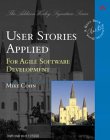
User Stories Applied
For Agile Software Development
Published:
2004
Pages:
257
Upcoming Events
| Apr 27 |
STAREAST Software Testing Conference in Orlando & Online |
| Jun 08 |
AI Con USA An Intelligence-Driven Future |
| Sep 21 |
STARWEST Software Testing Conference in Anaheim & Online |



User Comments
I was left with the same question as Michelle Carrier, where do the design go when the User Story ends (sometimes it is even ripped...)? My thought is that you should expand the User Story into a Use Case, which is also hinted in a discussion with Alistair Cockburn on the c2-wiki. The power of beginning with a User Story is that it is written by the Customer, and it is easier to discuss issues with the Customer over a User Story than over a Use Case.
From the reviewer's comments, I gather that she doesn't have much experience with agile software development processes. In Extreme Programming, requirements documents are seen as too limited and too static to properly communicate requirements; instead, high-bandwidth, dynamic, in-person communication is used. Story cards are just convenient tokens to represent particular portions of the conversation between everyone involved.